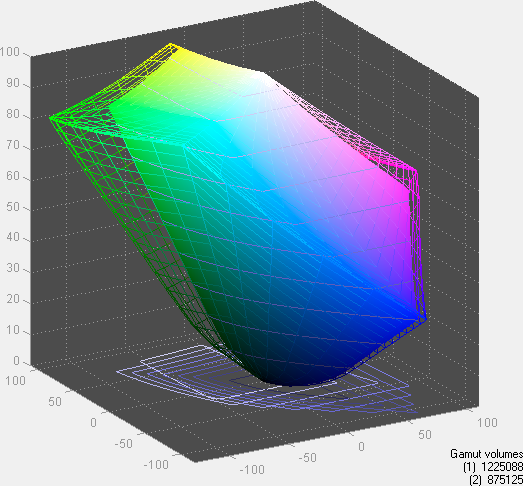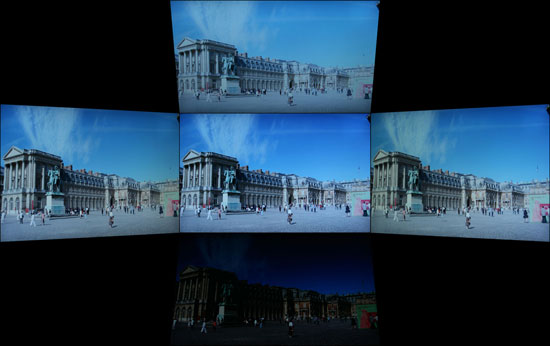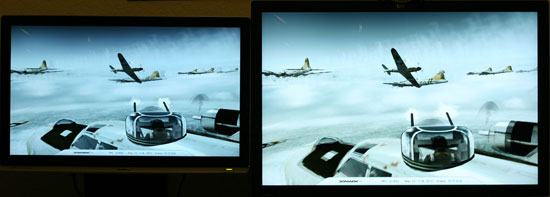BenQ E2200HD and E2400HD - 1080P FullHD LCDs
by Jarred Walton on November 4, 2008 5:00 AM EST- Posted in
- Displays
BenQ E2400HD Evaluation
Before we get to the charts comparing results with other LCDs, here's a closer look at the performance of the E2400HD. As usual, we have charts for color accuracy using Monaco Optix XR Pro and ColorEyes Display Pro with a DTP94 colorimeter, a 3D color gamut volume compared to the Adobe RGB 1998 standard, viewing angles, and input lag/pixel response time comparisons.


Overall color accuracy is good, with slightly better results than the E2200HD in several tests, but slightly worse results in a couple tests as well. This time, uncalibrated color accuracy is better under Monaco Optix than ColorEyes; in fact, the uncalibrated Optix result of 3.124 is extremely good compared to many other LCDs. Calibrated results have the E2400HD scoring just slightly better than that E2200HD in Optix XR, and just slightly worse in ColorEyes. However, the E2400HD does have one color that spikes above a Delta E of 3.0. Average dE after calibration of around 1.3 will be more than acceptable for most users.
Color gamut is slightly lower than the E2200HD and again nowhere near as high as some of the top displays. If you're an imaging professional using an expanded color space, a different LCD -- most likely one with an S-PVA or S-IPS panel -- would probably better serve you, but for the vast majority of users the E2400HD will be fine.
 |
Here we see the standard characteristics of a TN panel, with viewing angles that are worse than S-PVA, MVA, and S-IPS panels. Plop yourself down in front of the display, however, and it's unlikely you will ever have problems with the viewing angle.
 |
 |
Comparing the E2400HD with the HP LP3065, results are virtually identical. Out of 20 sample pictures (after we eliminated those that didn't clearly show one time at the bottom on both displays) only two pictures didn't have the same time code. We used these two images as the lag samples, one showing the E2400HD 10ms ahead and the other 10ms behind. You can also see differences in pixel response times, with the first picture favoring the HP LP3065 and showing significant pixel lag on the E2400HD, while the second picture shows the opposite. The net result is that differences in screen refreshes and camera shutter speed create small variations, which is why we compare input lag using multiple image samples (taken using a 1/125s shutter speed). On average, the E2400HD matches the performance of the HP LP3065.
Our summary of the E2200HD said that it was our current favorite among 22" LCDs, but the E2400HD has to go up against stiffer competition. If you view a lot of 16:9 content, the E2400HD might be the better choice for a 24" LCD, and for the price there's still a lot to like. However, Acer for example makes several competing 24" LCDs that cost up to $50 less than the E2400HD. Since we haven't been able to test those in person, we don't know if color accuracy is comparable or not, leaving us to compare the E2400HD with more expensive 24" LCDs. For the price, the E2400HD is one of the cheapest 24" LCDs currently on the market, and it still offers very good performance characteristics. Just beware of the issues with support for non-native resolutions, and you will want a DVI or HDMI cable and perhaps a better base stand. Add in those options and suddenly the price advantage disappears, making it more difficult for us to give it a wholehearted recommendation. It competes well with many of the other 24" LCDs we've tested -- like the Gateway FHD2400 and the Samsung 2493HM -- but it's not really better and definitely has a lower color gamut.










33 Comments
View All Comments
Meaker10 - Tuesday, November 4, 2008 - link
It's not having black bars or not, it's having black bars or no screen at all, I would rather have the black bars and the extra desktop space thanks.JarredWalton - Tuesday, November 4, 2008 - link
It's not a "rip-off" - it's a choice between two compromises. If you watch a 16:9 AR movie on a 16:10 LCD, the total size of the movie will be smaller than on a 16:9 AR LCD. FWIW, I'd go for the WUXGA 24" panels in most cases as well, but there are reasons to get native 16:9 instead. Since WUXGA is not an option on any current 22" panels, you get a higher desktop resolution and 1080P support - so you win both ways. That's one reason I gave it a Bronze award.Just for those who might be curious:
24" WUXGA = 259 in^2 screen area
24" 1080P = 246 in^2 screen area
1080P content on 24" WUXGA = 233 in^2 area
MadMan007 - Wednesday, November 5, 2008 - link
Lenovo makes a 22" WUXGA monitor.The reason people feel it's a ripoff is because it adds nothing to the value of a screen and is just a move for panel makers to reduce costs. Reduced cost is also part of the reason behind 16:10 widescreens but at least there's a benefit or reasonable tradeoff from 4:3 in terms of filling field of vision.
If 1920x1080 video content is the primary use for a display a TV would be a better purchase anyway.